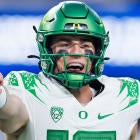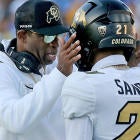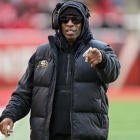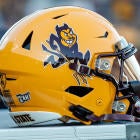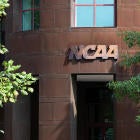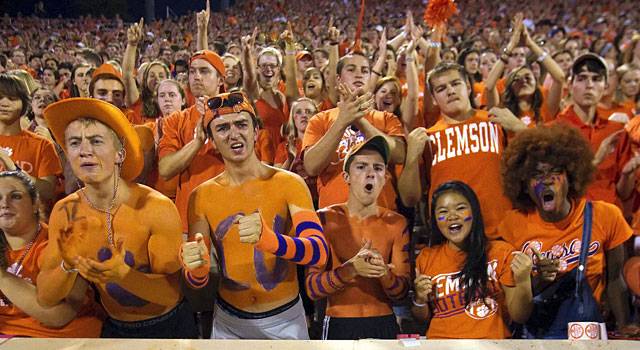
More: Dynamic price gains traction | Attendance down in '14 | Right stadium size?
Even before this week's concussion controversy, this had been a miserable season for Michigan both on the field and in the stands. Ticket sales slipped so far that Coca-Cola advertised two "free" Michigan-Minnesota tickets (total face value: $150) with the purchase of any two Coca-Cola products ($3).
Michigan labeled the promotion a "miscommunication" and pulled the offer while honoring all Coke purchases. By that point, the public relations damage had been done from a promotion that highlighted one way some athletic departments are trying to get fans to attend college football games.
Across the country, athletic departments are searching for ways to entice college football fans -- especially the next generation of season ticket-holders -- to fill their stadiums. The price of being a fan has never been higher, and the comfort of watching at home has never been easier.
The average announced attendance for Football Bowl Subdivision home games has been below 46,000 for five straight years after it peaked in 2008 at 46,456. Last year the average was 45,192.
Michigan athletic director Dave Brandon understands the reality of marketing college sports: Just win -- and the Wolverines haven't won nearly enough in recent years.
"That's why coaches are under such great pressure," Brandon said in late July. "Every one of them knows if they don't win, they're not going to be able to fill their stadiums, and if they don't fill their stadiums, it's going to put huge pressure on their academic or athletic budgets."
Brandon believes in a second motto to sell tickets: "You've got to have the games be more than games." This is why Michigan shoots off fireworks, performs laser light shows, drops parachuters, displays planes and helicopters in an air show, sends a man on a jet pack flying across the Big House, and even lands Beyonce on video to introduce Michigan's band.
"We're trying to find ways to keep younger people engaged," Brandon said, "because longterm it's going to be a problem."
Student attendance at college football games last year dropped 7.1 percent since 2009, according to an analysis by The Wall Street Journal of about 50 public colleges. The decline was 5.6 percent within the five major conferences.
Not even the SEC, with its rabid fan base, is immune from attendance declines. The SEC's nation-best 75,674 average in 2013 was slightly up from 2012, but still 2 percent below its crowds in 2008.
"Back in the day, going to a football game used to be the biggest thing you did in the fall," Georgia athletic director Greg McGarity said. "I think times are changing somewhat. I wish we could solve it right away. It is concerning that it is not the thing to do for the majority of your students on campus."
College football's explosion of money has come due to television deals. The flip side is nearly every game is broadcast, whether it's on a major TV channel, a conference-branded network, or through video streaming. Many of those home games aren't very attractive in relation to the prices.
It has become easier for the average fan to question the value of season tickets and travel costs. Why travel and spend money when you can watch multiple games better on your HDTV from the comfort of home?
"There's no substitute to being at a game, I don't care how good the screen is in your house," said Burke Magnus, ESPN senior vice president of programming acquisitions. "There are pros and cons to both sides. Personally, I love going to games. At the same time, I love being able to see 20 games instead of being at one. It cuts both ways."
The TV vs. attendance conflict has been building for years in college football. For too long, people in the sport often brushed aside the crowd declines as an anomaly or a byproduct of a down economy.
Not anymore. Leaders in college football seem more active than ever in addressing the challenge. This is how some are trying to tackle it.
College football studies Disney
Football games are no longer just games. They're events that fight for the attention and entertainment dollars of fans.
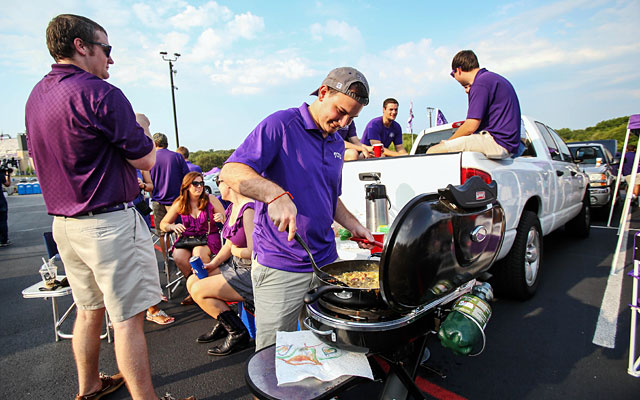
"People judge college athletics from an entertainment standpoint, rightly or wrongly, and I think they almost think if we spend this kind of money, it's like a family vacation to Disney," Mississippi State athletic director Scott Stricklin said. "They start comparing football season tickets to Disney, and Disney does it 365 days a year at a huge, massive scale at a level we're not at with staffing."
Increasingly, athletic departments are turning to Mickey Mouse for help on how to create a magical football experience.
Numerous schools have used the Disney Institute to reassess their football game experience. The Disney Institute is the professional development arm of The Walt Disney Company that gets hired by many industries, including healthcare, aviation, government/military, food/beverage and retail. The Disney Institute declined to identify or list the number of athletic departments that have worked with the company.
TCU started using the Disney Institute two years ago mainly to train gameday workers who are not full-time TCU employees on how to interact with fans.
"The fan does not know any different if the parking attendant is an employee or not an employee, but you've got to let the fan capture a little bit of that magic," TCU athletic director Chris Del Conte said. "When you look at Disneyland, the experience starts the moment you receive that ticket, and you feel the anticipation by the time you get on the airplane, and when you park your car, you know you're going to Disneyland. That's what we have to do at games."
Before training with the Disney Institute two years ago, Arizona State received consistent emails from dissatisfied fans about their gameday experience. One item in particular irked fans: Arizona State would sell footballs outside the stadium yet didn't allow fans to bring them inside.
"Fans for years were complaining about this, but we didn't have a way for our non full-time employees to register complaints up the chain and nothing would ever get done," said Rocky Harris, chief of staff of Arizona State's athletic department. "We created an internal reporting system to report it up to a manger and then to a full-time staffer to solve a problem."
Arizona State started having gameday workers wear fun name tags -- similar to Disneyland --- and say hello and goodbye to fans. The Sun Devils' season ticket renewals significantly increased. The team is winning, of course, and winning trumps everything. But Harris believes customer service is a factor for the high retention rate.
"I got at least 10 emails from fans who said, 'I had never gotten thanked before when I left,' " Harris said. "It sounds so small, but it's a collection of 100 little things that make fans happy. There's not one silver bullet that changes everything."
Arizona State coach Todd Graham believes fans become activated to buy tickets when they feel ownership with a team.
"My son loves going to spring training baseball games [in Arizona] because he gets three baseballs every time he goes," Graham said. "You've got to make fans out of them by the time they're 12."
In 2011, Auburn became one of the first athletic departments to work with the Disney Institute. The Tigers were coming off a national championship season, but "we saw some concerning attendance trends across the nation," Auburn athletic director Jay Jacobs said.
Auburn extended its gameday to a game weekend experience. The school offers locker-room tours, four-course meals on the football field the night before a game, additional free parking spaces and tailgating spots, and better food selections in the stadium. "You have to continue studying trends and what your fans want," Jacobs said.
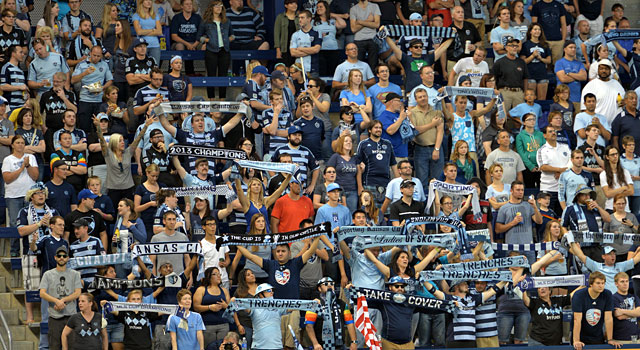
Can soccer help college football's technology?
Several SEC schools, including Florida, have visited Kansas City's Major League Soccer team, Sporting KC, to learn about fan engagement and technology. Sporting KC averages more than 20,000 fans per game after drawing 10,287 a game in 2010.
Sporting Innovations, the soccer team's spinoff consulting firm, is one of the leaders at collecting data of fans at a cost of several hundred thousand dollars. The data can tell a team all sorts of information, such as when fans bought tickets and who they sat near. Sporting KC built a stadium with advanced technology that provides fast WiFi and a unique mobile application that allows for instant replay, seat upgrades, customer feedback, social media integration and more.
Florida, by contrast, doesn't even have WiFi in its stadium yet. The Gators improved their antenna system for better basic phone service and is evaluating spending $2 million to $3 million on installing WiFi.
"It's not quite as simple as saying we're going to copy what Sporting KC is doing," Florida senior associate athletic director Mike Hill said. "But are there some opportunities? Potentially. We, like most colleges, are still lagging behind what the technological infrastructure requires to deliver the kind of services they're providing for their fans. When almost a quarter of your fans in the stadium are students and they want to upload and download photos, you need more capability."
Universities have been slow to keep up with technology for fans for several reasons. Part of it is universities tend to be more risk-averse than pro teams, who have larger staffs. Also, colleges see new expenses coming for athletes that will come out of the ever-increasing TV revenue.
And then there's this: "We have heard examples at the collegiate and professional level with infrastructure that are nightmarish," Hill said. "For us to spend that level of money, we want to have a high level of confidence it's going to work. It doesn't mean we're scared to make the decision. Once we feel confident in a solution, we'll follow that path."
The Pac-12 has partnered with Sporting Innovations for a longterm fan engagement initiative. Stanford is serving as the lab this year to explore the next evolution of college football fandom: Understanding the power of technology to engage fans in real time.
That could mean suggestions from fans as seemingly trivial as which music to play and what gets put on the video board. Every little thing can count in the fan experience.
"The engagement is so much bigger than the live game," Pac-12 chief marketing officer Danette Leighton said. "It's how each of our schools are interacting with each of their individual fans, and these days, everybody is customized and everything is different."
Leighton said the difficulty for college football is its demographics -- ages of 18 to 80 -- are much wider than in the NBA, NFL and MLS.
"That's what's been so different and maybe so challenging for collegiate athletics," Leighton said. "You can't just focus in [on one demographic], but that's also what makes us so special. We have this affinity fan base because maybe they were coming of age and found their alma mater, or they grew up with a region in which everybody went to that school."
Analyzing loads of consumer data is in its infancy in college sports, but it's coming. For instance, Hill could envision marketing weekday Florida basketball games specifically to fans who previously purchased weekday tickets.
"It's also one of those topics that people are trying to get their arms around it and say how do we manage it?" Hill said. "It's one thing to secure the data, but someone has to analyze it and effectively use the data for it to be valuable. Otherwise, it just sits there."
Why selling tickets matters
TV rules in college football during 2014. But in many ways, the lifeblood of an athletic department remains selling football tickets.
It's how you make money from parking, concessions and merchandise. It's how you get alumni back on your campus to donate money. It's how you build a fan base from a young age and on up. It's how you create a brand within a community.
It's also how you create a budget. In the Football Bowl Subdivision, ticket sales and donations (which are often tied to season tickets) remain the highest categories for generated revenues. For example, when Auburn's athletic department reported to the NCAA a deficit of $865,994 for a 2013 fiscal year in which the football team had a 3-9 record, football tickets and football donations accounted for 51 percent of Auburn's revenue.
Nineteen percent of the 87 FBS schools surveyed by CBSSports.com require a donation to purchase season tickets. That just gets you a seat into the stadium. It costs a lot more for the right to buy season tickets in good locations.
Ticket prices keep rising. In 2010, there were four face-value tickets that cost $100 or more; in 2014, CBSSports.com found at least 55 of those tickets. One of the most expensive face-value tickets in 2008 was $65 for Alabama-Auburn. Today, the Iron Bowl ticket costs $100 and a $65 ticket gets you into lower-profile games such as North Carolina-East Carolina and Tennessee-Vanderbilt.
| Price of 50-Yard-Line Season Ticket | ||
| CBSSports.com surveyed 88 Football Bowl Subdivision schools for data to calculate the costs per game to buy one lower-level season ticket at the 50-yard line. The calculations are based on the price of a 2014 season ticket and the required donation amount (if applicable). Some schools have multiple numbers because the cost depends on where a fan is seated at the 50 or when the tickets were purchased. These numbers generally cover only the total cost in 2014, not the lifetime donation level some schools require to have access to a seat at the 50. (Example: Georgia normally requires a priority level of at least $50,000 for this seat.) The cost of sitting at the 50 can be impacted by factors such as whether lifetime donation levels are required, stadium capacity, volume of other high-priced tickets, and the attractiveness and number of home games. |
||
| School | 50-Yard Line Season Ticket Cost | 2013 Record |
| * USC | $5,000, $1,741.67 | 10-4 |
| ** South Alabama | $1,687.67, $853.33, $436.67 | 6-6 |
| Duke | $1,035.71 | 10-4 |
| Iowa State | $767.86 | 3-9 |
| *** N.C. State | $759.93 | 3-9 |
| Texas | $658.33, $653.33, $491.67, $486.67 | 8-5 |
| Cincinnati | $637.50, $304.17 | 9-4 |
| Oklahoma State | $500-266.67, $226.67, $155 | 10-3 |
| UCLA | $465.67, $215.67, $174, $132.33 | 10-3 |
| Notre Dame | $452.50 | 9-4 |
| Stanford | $433.17, $266.50, $161.50 | 11-3 |
| Tennessee | $415.14 | 5-7 |
| Nebraska | $413.14, $91.71 | 9-4 |
| Maryland | $412.50 | 7-6 |
| Michigan | $365, $150.71 | 7-6 |
| Michigan State | $294, $129.71 | 13-1 |
| Alabama | $263.57, $145, $66.43 | 11-2 |
| Oregon State | $255.71, $155.71, $127.14, $112.86, $70 | 7-6 |
| Kansas State | $236.43, $95.71 | 8-5 |
| Texas-San Antonio | $220.83, $80.83 | 7-5 |
| Baylor | $216.67, $175 | 11-2 |
| LSU | $207.14 | 10-3 |
| Fresno State | $205, $80, $51.67 | 11-2 |
| Oregon | $203 | 11-2 |
| UCF | $201.67, $196.67 | 12-1 |
| SMU | $201.67-$60, $35 | 5-7 |
| Toledo | $196.67, $113.33, $46.67 | 7-5 |
| Texas Tech | $190.67 | 8-5 |
| Florida | $182.86 | 4-8 |
| Auburn | $181.43, $127.14, $101.43 | 12-2 |
| Washington | $170.86 | 9-4 |
| Louisville | $166.67, $83.33 | 12-1 |
| Utah | $162.50, $131.67, $120.83 | 5-7 |
| Mississippi State | $158.57, $144.29, $112.14, $65.71 | 7-6 |
| Arizona State | $156.50, $153.17, $149.83, $94, $90.67, $87.33 | 10-4 |
| Clemson | $154.29 | 11-2 |
| Georgia Tech | $153.33, $128.33 | 7-6 |
| West Virginia | $144.17 | 4-8 |
| Iowa | $142.14, $99.29 | 8-5 |
| San Jose State | $142, $62 | 6-6 |
| Penn State | $140.71, $69.29 | 7-5 |
| Ole Miss | $140.71, $122.86, $55 | 8-5 |
| Rice | $135 | 10-4 |
| Miami (Fla.) | $131.43, $89.29 | 9-4 |
| TCU | $121.43, $46.43 | 4-8 |
| Connecticut | $121.43 | 3-9 |
| Colorado | $117.86 | 4-8 |
| Wyoming | $116.33, $115 | 5-7 |
| Rutgers | $113.33 | 6-7 |
| North Texas | $110, $21.67 | 9-4 |
| South Carolina | $108.57, $98.57, $80.71 | 11-2 |
| Army | $107.40 | 3-9 |
| Kentucky | $103.86, $93.14, $71.71 | 2-10 |
| Idaho | $103 | 1-11 |
| Wisconsin | $102.14 | 9-4 |
| Georgia | $97.14 | 8-5 |
| Arizona | $89.29, $26.43 | 8-5 |
| Vanderbilt | $86.88 | 9-4 |
| Hawaii | $86.43 | 1-11 |
| Colorado State | $85.57 | 8-6 |
| Purdue | $74.71 | 1-11 |
| New Mexico | $71.67 | 3-9 |
| Louisiana Tech | $62 | 4-8 |
| Georgia State | $58.33, $20.83 | 0-12 |
| Navy | $56.29, $38.80 | 9-4 |
| Eastern Michigan | $55 | 2-10 |
| Arkansas | $50 | 3-9 |
| Nevada | $49.17, $45 | 4-8 |
| Louisiana-Monroe | $49 | 6-6 |
| Indiana | $43.33 | 5-7 |
| Pittsburgh | $42.71 | 7-6 |
| Northwestern | $42.71 | 5-7 |
| Tulsa | $41.67 | 3-9 |
| Troy | $40, $23 | 6-6 |
| Miami (Ohio) | $35.83 | 0-12 |
| Air Force | $33.33 | 2-10 |
| Temple | $28 | 2-10 |
| New Mexico State | $25 | 2-10 |
| Ball State | $18.50 | 10-3 |
| Bowling Green | $14, $12 | 10-4 |
| * -- USC has two options: a $30,000 annual donation that includes four complimentary season tickets and the option to buy four more; or a $10,000 annual donation with the ability to buy four season tickets. ** -- South Alabama requires minimum donations of $2,500, $5,000 or $10,000 that provides the donor with access to buy 24, 18 or 12 tickets. *** -- N.C. State requires a minimum donation of $25,000 payable over five years ($5,000 per year average used by CBSSports.com) rather than an annual amount for access to the 50. Note: Oklahoma, Illinois, East Carolina, Virginia Tech, Kansas, North Carolina, Virginia and Texas State also responded with season-ticket data. Due to complexities within their season ticket system or responses, determining a cost for 50-yard line season tickets was not possible. | ||
"Whenever you lose a game, ticket prices are too high," said Stricklin, Mississippi State's athletic director. "Whenever you win a game and somebody's after your coach, you've got to pay him more and fans say just charge us more on season tickets. I do think we need to be sensitive. You don't want to make a $10 increase on a season-ticket price to be the thing that tips someone from buying."
According to a study by Ohio University's Center for Sports Administration and stadium designer AECOM, athletic directors believe lowering ticket costs is the least effective option to draw fans. Eighty-four percent of schools plan to invest in significant facility improvements over the next five years. One in five plan to spend more than $50 million despite widespread funding concerns.
The survey of 136 athletic directors listed wireless connectivity as the highest priority for that stadium spending, followed by premium seating and food and beverage options. "ADs believe that star players and team rivalries are important at drawing new fans, followed by new, state-of-the-art facilities," the study said in a not-so-surprising admission that players possess value for fan interest.
More schools now sell ticket packages and discounts, such as special plans for families or young alumni. For a while, Georgia allotted 18,000 tickets for students but typically only had about 15,000 students attend each game. So Georgia reduced student tickets to 16,000 --it averaged 12,271 students per game in 2013 -- and created a young alumni program.
Any Georgia graduate within the past five years can sign up for season tickets at face value with no donation attached in the first year. By the second year, the required donation is $125 per seat (half price) and it increases to the full amount in the third year. Georgia had about 3,000 requests for young alumni seats so a lottery was held for the 2,000 seats.
Virginia Tech, which had 93 straight sellouts end in its 2013 season opener, now offers ticket packages for a few games for the first time. Syracuse coach Scott Shafer even offered to buy a second ticket to every fan that purchased one for the Villanova opener.
Sure, games are easy to watch at home from TV, "but it's hard to grin at the TV," Baylor coach Art Briles said. "You can grin at the TV but nobody is grinning back."
‘There's a different demographic out there'
When the SEC got the results back from its fan-experience study by a creative-strategy firm called Now What Research, the No. 1 complaint by fans was parking and traffic, said Stricklin, who chairs the SEC fan experience committee.
The study by Now What Research stated that fans first and foremost associate the SEC with a "win-at-all-cost mentality." The research firm encouraged the conference to "build a more multi-dimensional SEC brand that elevates the stadium experience and drives attendance when teams are losing." The study's short-term ideas:
- Create an SEC gameday app
- Conduct transparent surveys from each school or conference office
- Have a sign in each stadium that reads "Welcome to SEC Country"
- Create "micro-neighborhoods" within each stadium to give fans a deeper sense of belonging
- Improve cellular service and consider installing WiFi at stadiums
According to the SEC, at least 12 schools indicated they improved concessions for fans in 2014, at least eight schools improved restroom conditions, and at least eight schools took steps to improve cell service. Some added WiFi for fans in premium seating areas.
The SEC fan survey showed spectators often get bored during TV timeouts with too many on-field presentations. At Georgia, live action of other SEC games are shown on the video board during breaks. The SEC now allows music right up until the quarterback prepares to receive the snap.
The days of taking college football fans for granted appear to even be changing at Notre Dame, where its $400 million project to renovate the football stadium and construct new buildings will include a video board for the first time.
Notre Dame Stadium is as old school as it gets -- a fine game day environment that feels like a scene from the 1960s. When there are replay reviews, Irish fans gesture animatedly at media members -- who have the luxury of TVs in the press box -- to ask if a call will stand or be overturned.
"Our fans, especially our younger fans, have been clear in communicating their strong desire to have better access to data and video when attending our games -- a view that has been reinforced by their experience in other stadia when we host our Shamrock Series games," Notre Dame said in a statement about the stadium project.
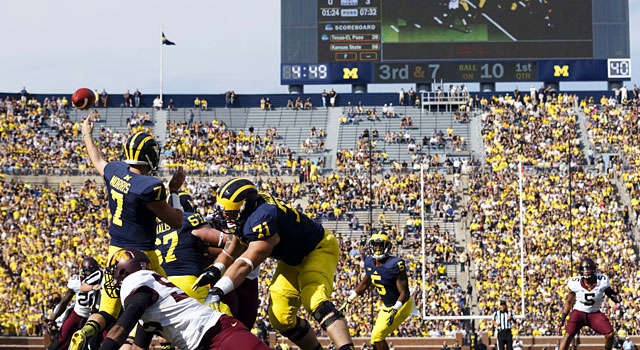
Michigan's student attendance dropped 10 percent in 2013. That occurred as student ticket prices increased from $205 to $295 and the university changed how it assigned student seats, causing dissatisfaction. Brandon, Michigan's AD, said this summer that about 12,000 student tickets had been sold (compared to 14,479 last year).
Big Ten expansion -- not to mention the fans' frustration with coach Brady Hoke -- won't help the Wolverines' 2014 attendance. Michigan's home schedule doesn't include Michigan State or Ohio State for the first time since 1966.
The secondary ticket market changed how fans buy tickets. Instead of purchasing directly from the school, fans often pay a premium at a site such as StubHub for attractive games they want to see while avoiding the season-ticket cost.
"People are becoming far more discriminating on which game they want to go to and spend the ticket price and spend the hours in the stadium," Brandon said. "In days gone by, people went to games to watch their team play, and I think many people now go to games to watch the other team play. They get to see their team play every week on TV."
So Brandon, who could soon face a decision on Hoke's future, creates events. Brandon dresses up football games that matter an awful lot to many people with bells and whistles. He acknowledges some of Michigan's new ideas bother traditional fans.
"They just want to see a football game, and if the band did the same music every time, they'd be happy," Brandon said. "But there's a different demographic out there that we're fighting for their attention and their loyalty. And we've got to reach them."
CBSSports.com senior college football columnist Dennis Dodd contributed to this article.












